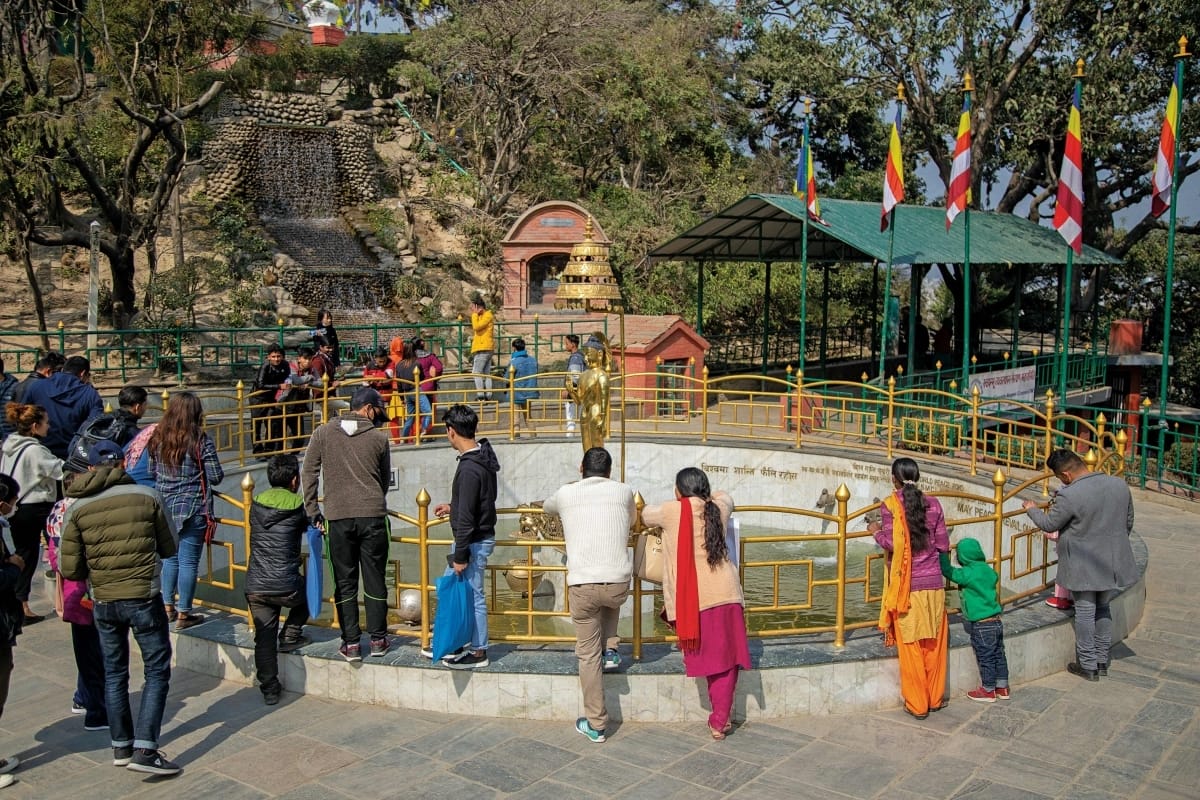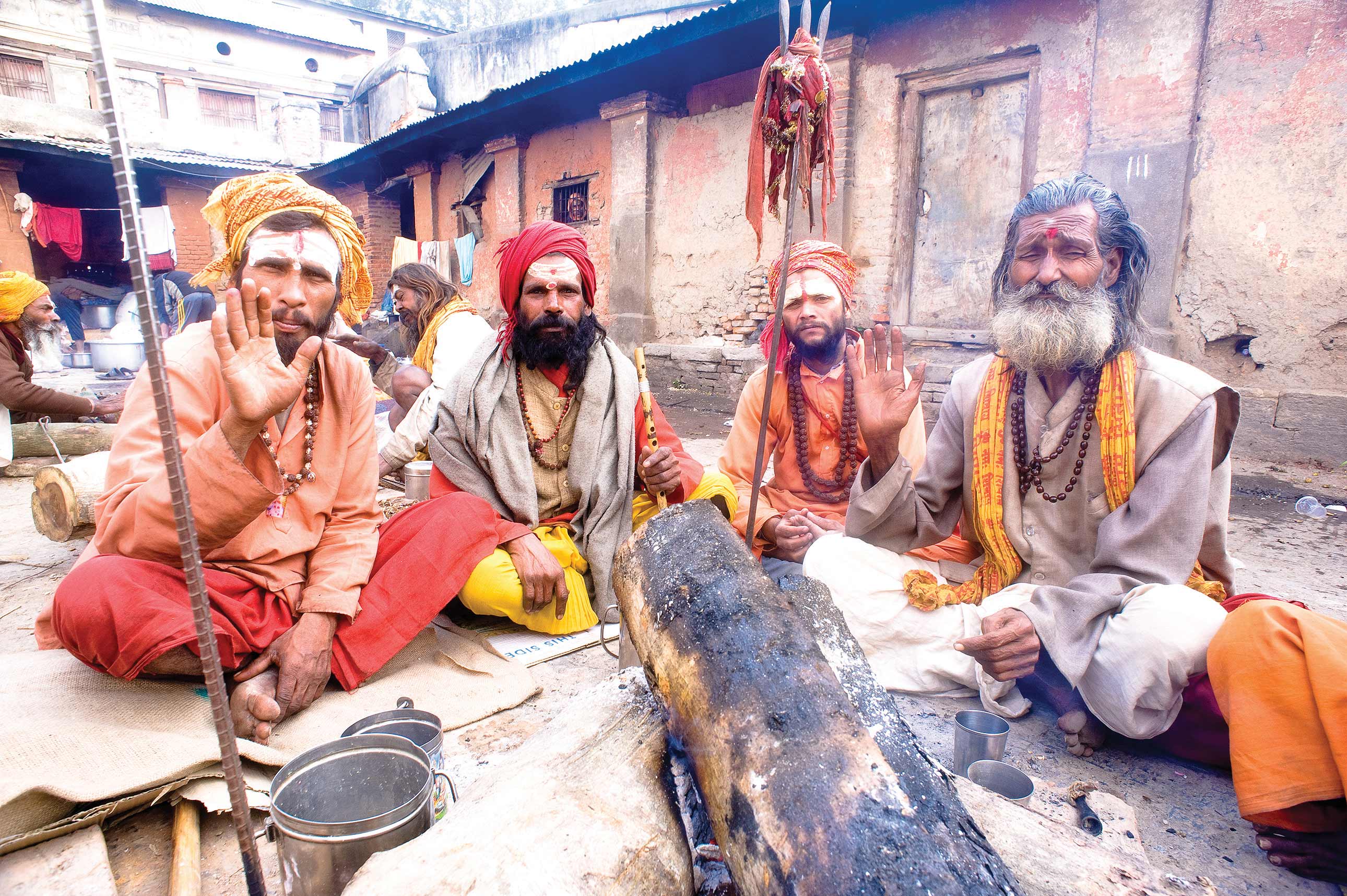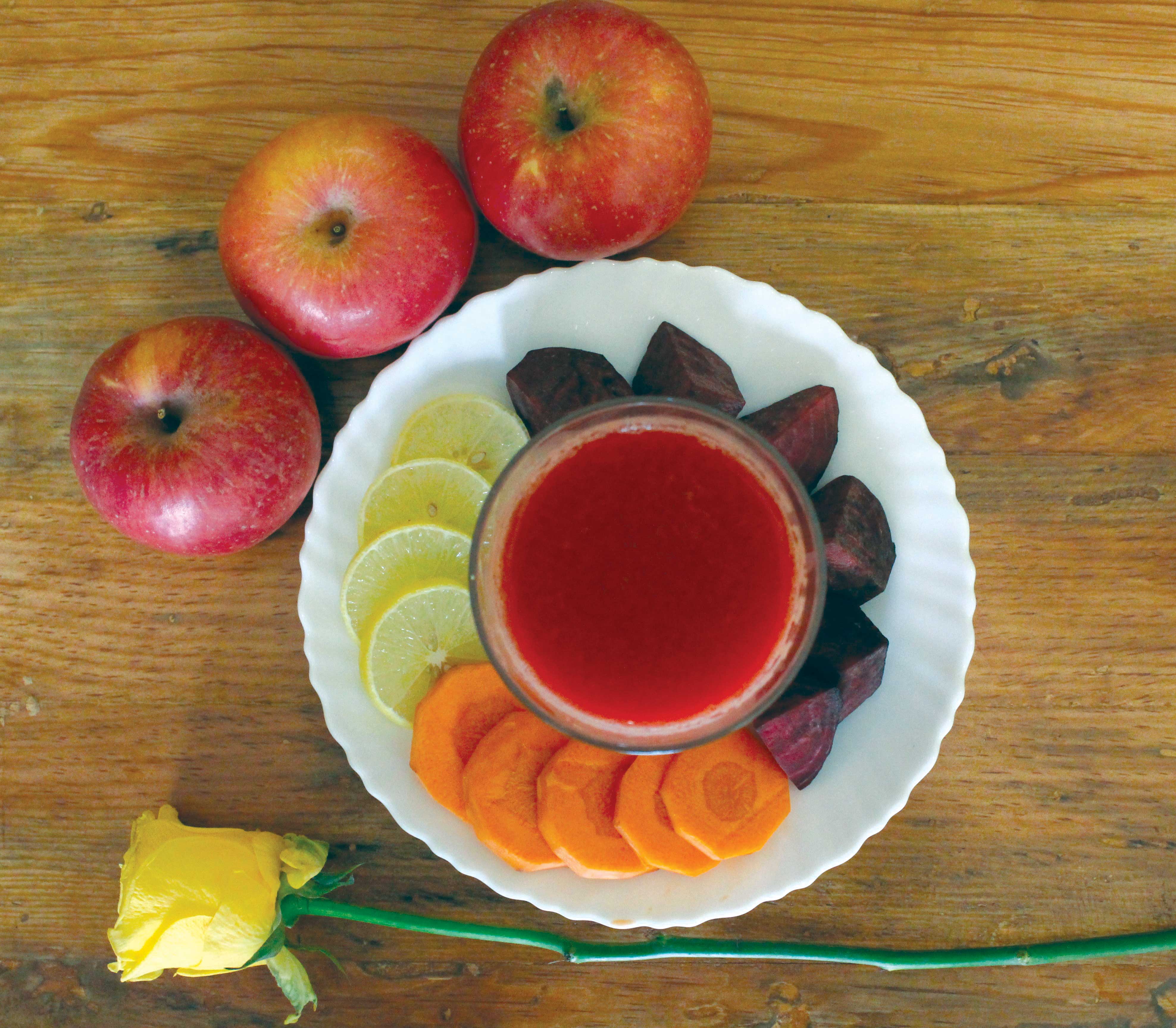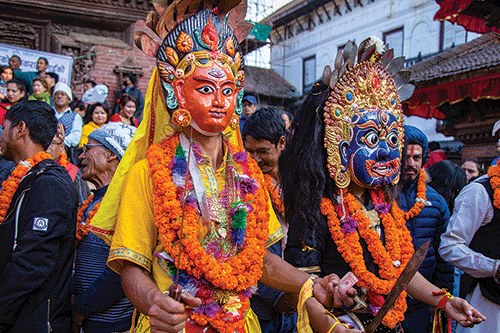
The first time I saw Mount Everest close up was December 1966, when trekking in the Khumbu was still a rare adventure. (It’s still an adventure, but not as rare now as half a century ago.) My trek into the ‘fabled valley’ and mountains was all the more memorable because Sir Edmund Hillary was there with his family. Thirteen years after he topped Everest with Tenzing Sherpa, Hillary was back building school houses and other projects, and celebrating Christmas with the Sherpas.
High over Khundé
I flew from Kathmandu in a Twin Pioneer operated by Nepal’s Royal Flight and piloted by Flight Lft. Ken Hart. The Twin Pioneer was a surprisingly maneuverable STOL (short take-off and landing) aircraft. As we approached the upper Khumbu Ken briefed me over the roar of the engines.
“Below us, on the left, you’ll see Namché Bazar,” he shouted, pointing ahead into a maze of mountains and river gorges. “Then we will fly directly over Khundé and Khumjung villages. Look closely, and you’ll see Ed Hillary’s new Hospital.”
Within minutes we were over the Khundé ridge, waggling our wings at the hospital staff waving up at us. Then we flew down past Khumjung over an old monastery with its new aluminum roof (another gift from Hillary) glinting in the bright sun. We turned over the Dudh Khosi (‘Milky River’) gorge below Tengboché monastery, and after a last glance at Ama Dablam, Taboché, and Mount Everest, Ken banked the plane and we descended in a slow glide south toward the tiny airfield at Lukla.
That brief tour above the Khumbu was a thrill, something rarely done today except for by occasional charter flying into the more recently built Syangboché field above Namché. Lukla field was short and rough (unpaved) with a 12% gradient. Today, the field is longer and paved, but still steep, which makes for exciting uphill landings and downhill take-offs.
Lukla was all potato fields and a few small farm houses. Today, it is big town full of hotels and shops, with potato fields somewhere off in the distance. It was the first airfield serving the Everest region, and is now one of the busiest in all of Nepal, especially during trekking season.
I had made prior arrangements to be met at the plane by a young Sherpa named Pasang Kami and a porter (his brother-in-law), Sona Iishi. In subsequent years, Pasang Kami became more well known as ‘P.K.’ while working as a popular guide and expedition sirdar. On this early trek, he and Sona Iishi were more than guide and porter to me. They became lifelong friends whom I had the pleasure of hosting at my home in America a few years later.
From the airfield we trekked north up the valley of the Dudh Khosi, taking our time to enjoy the countryside and the people. We arrived at Namché the next day.
On Christmas Eve, we trekked over the ridge to Khundé and spent a delightful evening with the hospital doctor and the Hillarys, sipping Christmas brandy and ‘talking mountains’. During the holiday, the Hillarys hosted a Children’s Christmas festival featuring Father Christmas played by Max Pearl, one of Sir Edmund’s colleagues. This New Zealand version of Santa Claus arrived dressed in a red parka, riding a dzopkyo (yak crossbreed), tossing hard candies to the gleeful youngsters. The rest of the day was spent playing games.
There was also a short high altitude marathon in which Hillary’s New Zealand mountaineer friends challenged the local Sherpas. A Sherpa won. The 1966 race was a predecessor (perhaps the very first) to what is now known as the Everest Marathon.
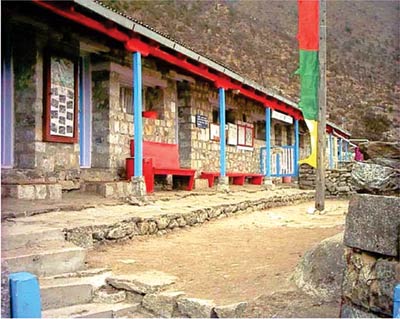 Kapa Kalden
Kapa Kalden
In nearby Khumjung we visited the aging Kapa Kalden, a noted Sherpa artist, and his (then) young son, Pasang. As a ‘kapa’ (artist), Kalden deviated slightly from the traditional Tibetan style of religious painting to illustrate common village and mountain scenes with sacred overtones. While he lived, his unique landscapes avidly bought up by early foreign visitors to the Khumbu. Today, they are collectors’ items.
The artist and writer Desmond Doig once wrote this about Kalden’s paintings:
With stylized simplicity, the Sherpa artist Kalden portrays the Himalayan homeland of his people, brave, devout, and incredibly hardy mountaineers. Clouds with buttonhook eyes wreath the peak of Khumbila, so sacred that no Sherpa may stand on its summit. Above the village of Khumjung, lamas and laity pray before a flag-bedecked shrine. Stair-stepped houses crowd close to a Buddhist temple. Women trudge through the streets with back-packs, while cattle roam near the chortens harboring revered relics.
Many of Kalden’s paintings feature sacred Khumbila peak overlooking and protecting the Khumbu, along with local temples, monasteries and Sherpa houses. One in my small collection also shows the Hillary school below Khumjung and the Hillary hospital at Khundé. Another is of Tengboché monastery, surrounded by mountains and shrines and chortens, and a few of the artist’s benefactors (buyers)mountaineers and trekkers being served tea and snacks by the Sherpas. And, often as not, there’s a Tibetan mastiff dog in his pictures.
Gipfeln und Wipfeln
The trail to Tengboché monastery goes east out of Khumjung, down across the Dudh Khosi gorge, then up a long forested ridge. Ama Dablam peak, resembling a ‘Mother’s Charmbox’ to the Sherpas, towers overhead. I had heard a lot about the beauty and tranquility of Tengboché, and was enthralled as I entered the monastery compound. “Not a breath of wind stirred, not a person was seen,” I wrote later. “High in the north eastward, far above t Everest sailed silently the Imja Valley. I he snow plume of stood breathless and drank in the austere silence and peace...” It reminded me of these lines (in German) from Goethe’s ‘Ein Gleiches’:
| Über allen Gipfe | ln Over all heights |
| Ist Ruh; | is peace; |
| In allen Wipfeln | In all treetops |
| Spürest du | You feel |
| Kaum einen Hauch; | hardly a breath. |
| Die Vögelein schweigen in Walde... | The little birds are silent in the woods... |
At the monastery, Pasang Kami and I had tea with the young abbot and chatted with some of the Buddhist monks. We were their only visitors, for in those days relatively few foreigners came to the Khumbu (except during climbing season). That was well before the trek to Everest Base Camp (EBC) became so popular and hordes of trekkers began jamming the trails and inns and crowding into the bakery cafés at dawn to buy oven fresh pastries. None of that existed back in the 1960s. Instead, the Khumbu I experienced looked and felt much as it had for many generations.
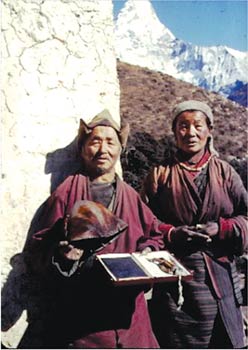 Rigi-kur and Tom-gi Nima
Rigi-kur and Tom-gi Nima
The next night, near the village of Pangboché, P.K.’s wife, Namdo, prepared rigi-kur for dinner. Rigi-kur is a Sherpa culinary specialty, a thick potato pancake cooked on a hot flat rock over the campfire. It is served with a smelly cheese called somar, along with yak butter, fresh garlic, Tibetan salt and a liberal sprinkling of red chili powder to give it zing. It is eaten with the fingers. One is a whole meal.
Late the same evening I stood alone in the cold watching the alpenglow paint the high peaks a fiery orange. The Sherpas call it Tom-gi Nima, the ‘Bear’s Sun’. A violent wind was sweeping across Everest creating the peak’s tell-tale plume streaking east, high into the night sky. The dramatic effect reminded me of Robert Frost’s ‘Fire and Ice’:
Some say the world will end in fire,
Some say in ice.
From what I’ve tasted of desire
I hold with those who favor fire.
But if it had to perish twice,
I think I know enough of hate
To say that for destruction ice
Is also great
And would suffice.
It was so late in the season, and so cold, that beyond Pangboché we were alone on the trail. As we passed the mouth of the Imja valley to our east, we saw the trail coming down from Dingboché, the last and highest Sherpa settlement in the Khumbu. We would visit it on our return. For now we kept going up the Khumbu valley past the summer huts of Pheriché, where the Himalayan Rescue Association runs a small hospital today, then on through Phulung Karpo, the ‘Highlands of the White Ox’.
Death of a sadhu
At the high pasture of Dughla we spent the night in an empty yak herder’s hut. It was there that Pasang Kami told me the strange story of a Hindu sadhu (holy man) who had trudged up here from India about the time of the 1963 American Mount Everest Expedition. At Dughla the scantily clad old yogi informed the Sherpas that he was about to die. Then he composed himself in contemplation, waited..., and soon expired. The Sherpas buried him beneath the earthen floor, in a shallow grave under the very spot where I where I slept that night. Am I superstitious? No. But I shuddered thinking about.
Continuing on up the Khumbu glacier, we passed through Lobuché where in those days there was only one stone hut. Today, Lobuché features big hotels with fancy menus, soft beds and hot showers. That would have been nice!
The view from Gorak Shep
On the afternoon of December 31, we arrived at our highest camp, Gorak Shep. We spent a bitter cold night in our tents, and awoke to celebrate New Year’s Day 1967 by trekking up the glacier to what is now known as ‘Old Everest Base Camp’. It was a “tortuous route,” I wrote in my journal. “The moraine and a maze of seracs were the most demanding obstacles.” Pasang Kami knew the best way to EBC. He had been there the year before, carrying supplies up to the South Col on the 1965 Indian Everest Expedition.
From base camp we had a grand view of the Khumbu Icefall, but what we saw strewn around the campsite was disgusting. I described it in my notes as “Frankly, a garbage dump. Refuse from all the major expeditions lay strewn over the tossed and jumbled ice and moraine in an endless eyeful.” It was decidedly unpoetic; but, thankfully, there are periodic expeditions specifically to clean up the litter. We made sure that we left nothing behind.
On January 2nd we climbed Kala Patthar, the ‘Black Slab’, 410 meters straight uphill from Gorak Shep. “The wind whistled cold as both Pasang Kami and I fingered my cameras, tripping shutters in a free-for-all of fabulous views,” I wrote. From the top we had a clear view of some of the world’s most impressive peaks. “To the east was the Everest summit, the West Ridge, the South Col, Lhotsé, and Nuptsé. South of the Khumbu glacier rose Ama Dablam, Kangtega, Tamserku, Taboché, and Tsholatsé peaks. Westward, out over a sheer 1,000 foot vertical drop from our perch, spread the glaciers of Changri La. And towering tranquilly over us, almost at touching distance it seemed, [was] the white cone dome of Pumo Ri”.
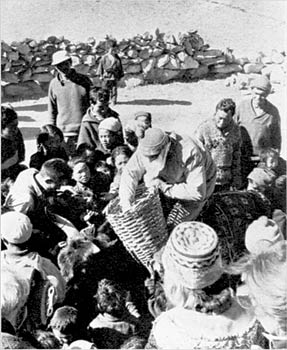 Kongma La
Kongma La
On our return down from Gorak Shep we camped one night at Lobuché. The following day Pasang Kami and I crossed to the east side of the glacier and climbed steeply up and over Kongma La (pass). Along the way we saw what gave the pass its name, flocks of pheasants, kongma to the Sherpas.
From the top of the pass, the track dropped precariously down to a frozen lake, and from there we had a long trek out and down to Dingboché. We arrived late, and spent the night in the house of Dingboché’s only winter resident, a toothless old Sherpa lady. Nowadays there are better accommodations.
Yeti scalp and guestbook
The following day we stopped at Pangbgoché and visited the small temple on the hill. There we were shown the famous ‘yeti scalp’ and hand. Sadly, the yeti scalp was later stolen away.
Thirty-seven years later, in 2004, I returned to Pangboché. The old temple was closed to visitors, but I persuaded the elderly caretaker to retrieve the dusty old guestbooks from a box in an attic. After some searching I found the page with my 1967 signature, just below those of Willi Unsoeld and family who had visited Pangboché some days ahead of me. Willi Unsoeld had summited Everest three years earlier, on the 1963 American Mount Everest Expedition while on leave as director of the Peace Corps in Nepal. After that he worked for USAID in Kathmandu.
An ‘other world’
One evening, back at Tengboché, I slipped into the dark kitchen room and sat with the monks around a dying fire while they ate a thick Sherpa stew with bread. I watched and listened and took notes as the youngest novices bore the brunt of many jokes and pranks, taking it all in good spirits. The glow from the dying embers caught their smiling faces and highlighted their dark red robes. And though I understood little of what was said, I felt a sense of communion.
Fyodor Dostoevsky once wrote that “Much on earth is hidden from us, but to make up for that, we have been given a precious mystic sense of our living bond with the other world...” Was this the sort of “other world” he meant, I wondered. Whatever, it was a magical moment for me, rich with ancient and mystical religious tradition, in a place located about as far as one could go in those days through the Khumbu to the edge of Tibet.
I left Tengboché the next morning with a khata scarf from the abbot around my neck and the haunting gong of the monk’s call to prayer echoing behind me.
Sometimes happenings that last only moments stay with us for years.


